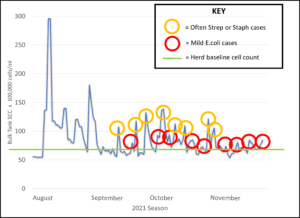Pay attention to detail, don’t cut corners. Vet Lisa Whitfield gives a lesson in stripping the herd.
It has been a really good season so far with regards to mastitis in the herd – the bulk tank cell count is 21% down on last season and the clinical cases have been few and far between in the milkers. As I write this, the bulk tank average for the season to date is 84,000 cells/ml and currently the daily pick-ups are around 69,000 cells/ml.
We are still learning every day about mastitis dynamics in the herd, and have made some interesting new observations this season. The baseline cell count for the herd sits between 60 and 70,000 cells/ml this season and we know when it goes above 70,000 that there is a mastitis case, so we use this generally as our trigger to strip the herd at the moment. 
Stripping the herd is a pain in the arse for a lot of people, and it is no different here. In this herd (260 cows OAD) it generally only requires a solo milker at this point in the season. Stripping the herd requires an extra labour unit in the shed, it adds about 20 minutes to the milking time which is a nuisance because we are first on the AB run, and it usually means a new red cow out of supply for a few days.
We have observed something interesting this season, with running a lower than usual cell count – mild E.coli mastitis cases are more readily detectable, and interestingly they are frequently cropping up in cows that have been on heat in the last day or two.
A normal, mild E.coli mastitis case tends to bump the cell count up to around 85,000 cells/ml (bulk tank up by 15 to 20,000 cells/ml) and within two or three days the cell count is back down to baseline again. By the time we have bulk tank cell count in on daily pickups, then have stripped the herd the next morning and found the cow, she is well on the road to recovery, and may only be out of supply for one milking, not needing more than a shot of anti-inflammatory as treatment. The Strep or Staph cases we see tend to put the cell count up to 110,000 cells/ml (up by about 40,000 cells/ml) until the cow is out of the vat.
And so it was that the cell count yesterday was 85,000 cells/ml, and the herd was stripped at milking this morning. It was my job to strip the herd – and I’ll be honest, it’s not my favourite job – I tend to get cramp in my hands after a few rows which makes the job physically uncomfortable. So I really thought I’d struck it lucky when on just the second cow in the first row, I stripped clots in the front right and found the clinical case.
As is always the temptation – I keenly suggested that perhaps we didn’t need to bother with stripping the whole herd today seeing as we had found our clinical case. The suggestion is made so we can have an easier milking, but as we always do, we carry on and strip the whole herd regardless. And as usual, there is a lesson to be learnt from resisting the desire to take the easy way out. Why do we bother?
Well, we carry on, the second row is being stripped, and the fourth cow in the row has clots in her front left, another clinical quarter! So not just one, but two clinical cases. The fourth row is being stripped, and the sixth cow in I strip blood from her back right quarter. She has clearly had a big knock to her udder and is bleeding into the quarter. Strawberry milkshake anyone? – with that amount of fresh blood, it is lucky she was found prior to being milked into supply.
This demonstrates the lesson for why we always strip the whole herd, even if we feel like stopping after finding one clinical cow and having an easy day.
All our clinical cases get milk sampled and cultured – we culture them ourselves using our own cheap, basic system. The two clinical cases are treated with an antibiotic tube and an anti-inflammatory, while the cow with bloody milk just gets an antiinflammatory. After we have the culture results, we review the treatment plan and decide whether any changes are needed.
Later that day we see the bulk tank cell count has risen to 109,000 cells/ml which fits with finding the two clinical cases that morning. My bet is on two mild E.coli cases and nothing from the trauma case.
It takes less than 24 hours to get a culture result for the cows. From the three quarters milk sampled, the results were – no growth from the cow with the bloody milk, and Strep uberis from the other two clinical cases. The cow with blood is milked out of supply until her milk is clear. She gets anti-inflammatories for pain relief as her only treatment. The two Strep uberis cases continue treatment with intramammary tubes for a total of three days. And the bulk tank cell count drops back down to 74,000 cells/ml. Job done.
- Lisa Whitfield is a Manawatu-based production animal veterinarian




